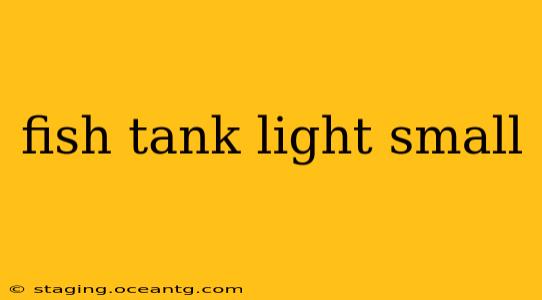Finding the right light for your small fish tank can feel overwhelming. With so many options on the market, from simple clip-on lights to sophisticated LED systems, it's crucial to understand what factors to consider to ensure your aquatic friends thrive. This guide will help you navigate the choices and select the ideal lighting solution for your miniature underwater world.
What Size Light Do I Need for My Small Fish Tank?
The size of your light directly impacts the aquarium's lighting coverage. For small tanks (generally under 10 gallons), you'll want a light that completely illuminates the tank's surface. Avoid lights too large, as they might create unnecessary glare or be overkill for the space. Measure your tank's length and width to find a light with a suitable footprint. Many manufacturers specify the tank size range their lights are designed for, making the selection process simpler.
What are the Different Types of Small Fish Tank Lights?
Several lighting options are available for small aquariums, each with its own advantages and disadvantages:
Clip-on Lights:
These are a budget-friendly and easy-to-install option, ideal for smaller tanks. They typically clip onto the rim of the aquarium, providing a straightforward lighting solution. However, they might not be as aesthetically pleasing or offer the same level of control as other options.
LED Strip Lights:
LED strip lights are versatile and energy-efficient. They're available in various lengths and colors, offering customization possibilities for your tank's ambiance. They can be affixed to the tank's rim or even placed underneath the tank for a unique effect. Look for waterproof and submersible options if you're considering underwater placement.
Hood Lights:
Integrated into tank hoods, these lights are a clean and convenient option. They often come pre-packaged with the aquarium, providing a complete setup. However, they might lack flexibility in terms of light intensity and color adjustment.
What Kind of Light Spectrum is Best for My Fish?
The light spectrum is crucial for plant growth and fish health. Full-spectrum lighting, mimicking natural sunlight, is generally recommended, as it provides a balance of wavelengths that support photosynthesis and encourages vibrant fish colors. Look for lights that advertise a full-spectrum output or specify the Kelvin (K) rating – a higher K value indicates a cooler, bluer light, while a lower K value represents a warmer, redder light. A balance is key for a healthy ecosystem.
How Many Hours of Light Does My Small Fish Tank Need?
The ideal lighting duration depends on the inhabitants of your tank. Generally, 8-10 hours of light per day is suitable for most small aquariums. However, if you have live plants, they might require slightly longer periods of illumination. Consider a timer to maintain a consistent lighting schedule, promoting a stable environment for your fish. Over-lighting can lead to algae blooms, while under-lighting can hinder plant growth and fish health.
Can I Use a Regular Lamp for My Small Fish Tank?
While you might be tempted to use a household lamp, it's generally not recommended for several reasons: The heat generated by a typical bulb can overheat your tank water, potentially harming your fish. Also, standard lamps usually don't provide the ideal light spectrum for an aquarium environment. Using specialized aquarium lights ensures the optimal balance of light intensity and spectrum needed for your fish and plants.
How Much Does a Small Fish Tank Light Cost?
The cost varies greatly depending on the type of light, features, and brand. You can find affordable clip-on lights for under $20, while more advanced LED systems can cost upwards of $50 or more. Consider your budget and the features you require when selecting a light for your small fish tank.
By carefully considering these factors, you can choose a small fish tank light that will provide the perfect environment for your aquatic pets, ensuring they thrive and bringing joy to your home. Remember, researching specific light requirements for the types of fish and plants in your tank will further optimize their health and well-being.
